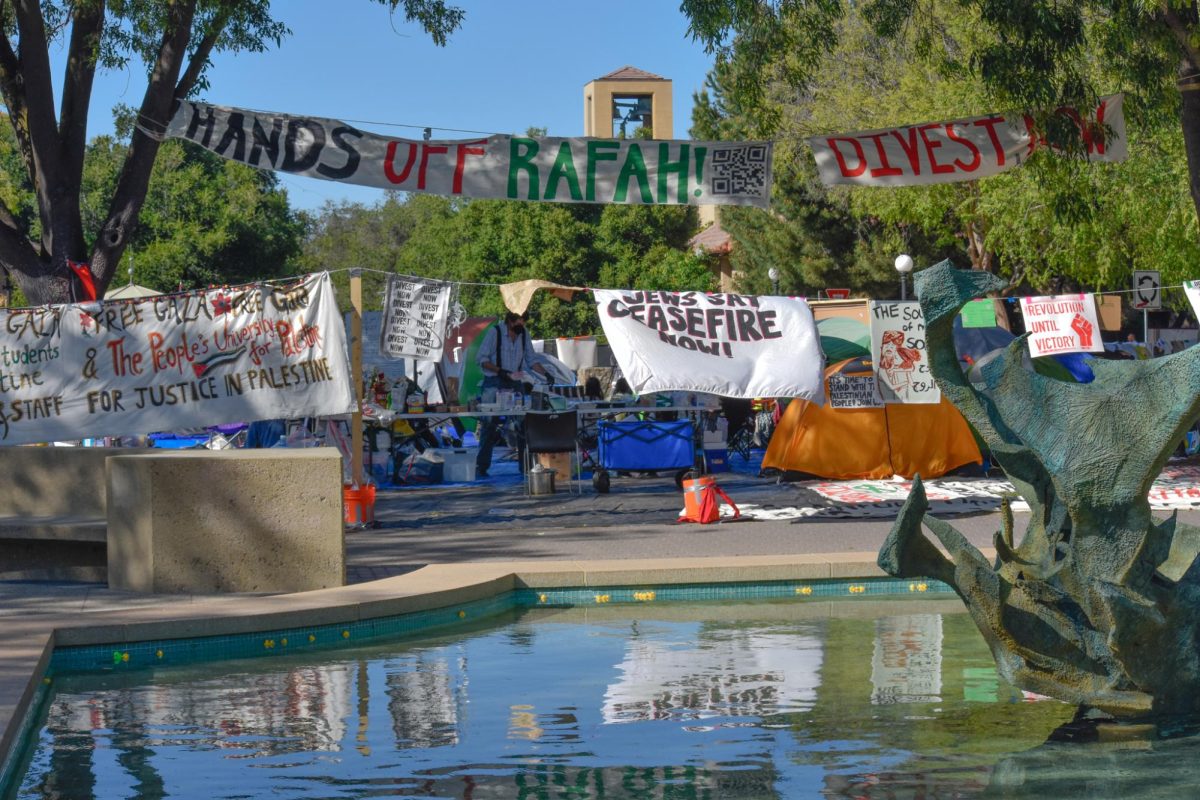For a ‘liberated zone,’ as declared by a black, red, and green poster in the camp, it’s not large. Two dozen or so tents. A community library. And plenty of banners, posters, and signage plastered all around its compact perimeter.
But here in White Plaza, the heart of Stanford, pro-Palestinian protestors have entrenched themselves. As universities struggle to extinguish protests over their perceived role in the ongoing Israel-Gaza War, the “Sit In to Stop Genocide” has become the most visible aspect of student discontent over the conflict.
Since April 25, protestors have occupied part of White Plaza, an area usually reserved for student-led events, concerts, and fairs. Students have been engaged in sit-ins here for over 120 days, with the ongoing encampment being only its most recent iteration. Students clad in Palestinian keffiyeh and masks descend onto the camp to participate in daily teach-ins, classes, activities, and vigils.
And it’s clear from the scenes nationwide why these events are important for the students.
At the University of California, Los Angeles, the encampment there suffered two nights of consecutive violence. Protesters and counter-protesters faced off in fierce battles before the police eventually shut down the encampment. At Columbia, hundreds of demonstrators were arrested after Hamilton Hall was occupied, with riot police dispersing both the encampment and the occupied building.
The number of arrests has now reached over 2,000 nationally.
Yungsu Kim, a Stanford student organizer and demonstrator, makes that contrast glaringly obvious.
“It’s terrifying to watch because quite frankly, if you go to Stanford University, there’s a good chance you know someone who goes to Columbia,” Kim said. “You know someone who goes to USC, you know someone who goes to UCLA.”
Around the camp, a visible police presence occasionally patrols the area. Kim said that the police presence is there not to protect them, but to serve as an attempt to intimidate the protestors.
“They’ve stationed all these security guards around here to intimidate us,” Kim said. “They’ve put police all around the perimeter to intimidate us saying that these things are quote-unquote, ‘for our safety,’ we know that’s bullshit.”
Stanford’s administration has sent several notices to the encampment, prohibiting demonstrators from camping overnight or forming a permanent occupation. In extreme cases, students have been summoned to disciplinary hearings. Kim pointed out that while students are sleeping in the tents, they do so out of protest.
“We know we’re breaking rules,” Kim said. “That wouldn’t really be civil disobedience if we weren’t breaking rules, right? Being out here in the cold and these tents is another way of them [the protestors] committing themselves to the fight for a free Palestine.”
Establishing a “People’s University of Palestine,” as it’s been termed, has played a significant role in all of this. Run by mostly anonymous student leaders, they manage a variety of daily teach-ins. Speakers lead communal readings of Palestinian poetry, run nightly prayer sessions, and organize poster-making workshops. Instructors roleplay how to avoid confrontations with counter-protestors or police, including those threatening violence.
And despite everything, there is a cautious peace around the camp. Life goes about as normal. Students still participate in their daily classes, as evident by the study sessions offered in the public itinerary. It’s a reminder that for the most part, the people in the student encampment are just that: mostly students.
Out of fear of getting doxxed, Jenny, a Stanford student, only gave her first name. Jenny comments on photos circulating of an anti-Israel protester wearing a Hamas headband. The images, which made rounds on national news, were submitted to the Federal Bureau of Investigation by the university on May 3.
“We had absolutely no idea who he is,” Jenny said. “They [student-led security team] would not let him in with the Hamas headband on.”
“We did not welcome him into our encampment. We did not affiliate ourselves with him.”
The concerns about the open espousal of hatred, however, still remain very pressing. The Anti-Defamation League reported earlier this year that incidents of anti-semitism have “skyrocketed” by over 360% in the aftermath of the Oct. 7 attack. Jane, a Paly sophomore who wished to use a pseudonym, voiced her concerns about the encampment as a Jewish student.
“My sister goes to UCLA and it [the encampment] is creating a very hostile and unsafe environment that I would not want to be around,” Jane said. “I don’t think that students should be able to make other students feel unsafe in their own school.”
The chants said at these camps have also come under fire. The phrase “From the river to the sea,” a common phrase chanted at encampments, has been classified as anti-semitic by the ADL. Critics have said that the phrase calls for the destruction of Israel, while supporters have argued it’s a broader call for Palestinian nationhood. Jane said that many of the students who are protesting don’t understand the gravity of what they’re saying.
“I’m not sure if all the students understand the chants that they say, but often, many of them have intentions that are anti-semitic.” Jane said. “And many of the common chants you hear in itself are anti-semitic. Because if they’re against Israel, and often against Jews, it’s very targeted.”
